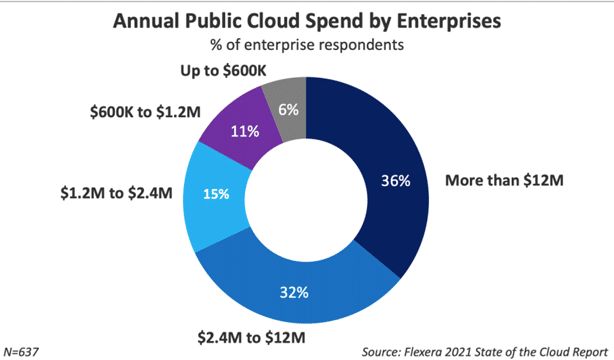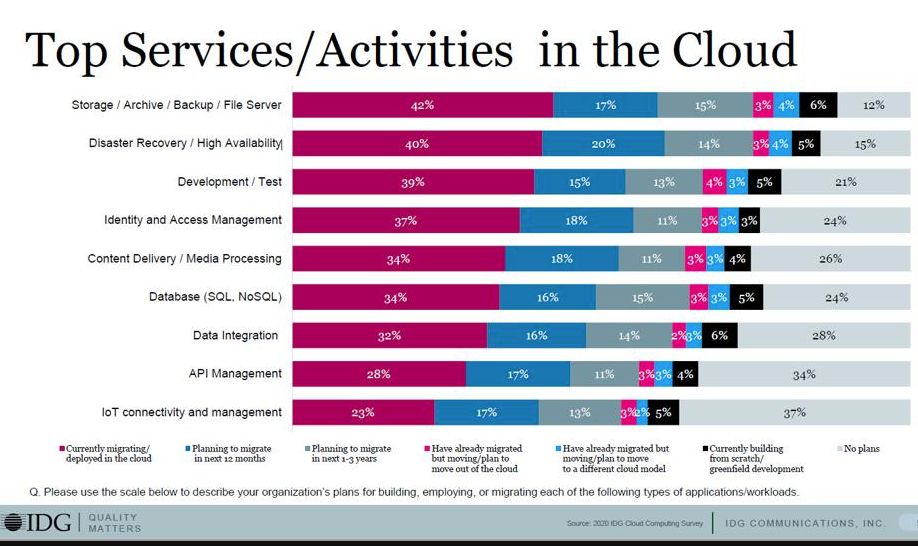Before you can get a clear picture of what cloud development is, you need to first understand where it’s coming from and what’s driving its growth.
In 2019, before the COVID-19 pandemic hit, the cloud market was growing at over 30% annually, according to Deloitte. Yet, despite the dramatic changes wrought by the virus on all sectors of the economy, cloud growth remained resilient.
In fact, according to the Progress Data Connectivity report, 1,008 out of 1,800 IT professionals said they planned to migrate to the cloud right away and throughout 2021.
How Cloud Development and Cloud Adoption Go Hand in Hand
To date, we’re still seeing spending on cloud services continue to rise, with the average enterprise spending $12 million to expand its cloud strategy.

Gartner now predicts that the global public cloud services market will grow by 23.1% in 2021 alone.

So why are organizations spending so much on cloud migration? The surveys mentioned above provide some perspective. Specifically, the Flexera and Gartner reports identified the following cloud objectives amongst participants’ responses:
- Modernize legacy and on-premises systems to serve contemporary customer demands
- Provide work-from-home support
- Reduce hardware and software purchases, maintenance, and replacement costs
- Utilize cloud providers’ expertise to manage their cloud based services
- Automate and use other emerging cloud based technologies, such as containers, microservices, and hybrid clouds, to provide resilient, scalable, distributed, cost-effective, and reliable customer services

There’s a catch, though.
Organizations can only reap these benefits if they use software and business processes that take advantage of cloud computing capabilities, including:
- Scalable computing resources that are available any time, anywhere
- The ability to spend less on IT hardware and maintenance in the long-term
- Cloud’s high degree of availability
- The ability to build cloud services and test them using persistent, scalable, and standard tools
- Fast service across various devices
- The ability to apply a DevOps approach to software development, with developers and operators working together to deliver high-quality programs fast, efficiently, and more frequently (including installing updates and security patches to make sure customers and employees don’t experience software-related issues)
That said, cloud applications need to be architected efficiently to take advantage of those capabilities. This is where cloud development comes in.
Cloud Development Explained: What is Cloud Development in Simple Terms?
Cloud development refers to the process of building, deploying, testing, and improving cloud services within a cloud environment. It is also called cloud based development and in-cloud development.
The main focus of cloud development is on developing applications in cloud environments, which are also known as cloud software.
What is cloud software?
You can think of cloud software as any program that you can access and operate via the internet. Cloud based development helps organizations create and use cloud applications instead of continuing to use local data centers.
Some organizations prefer to migrate and keep their legacy applications as-is for cost and speed-of-deployment reasons. Despite this, the top goal of cloud application development is to create cloud-native applications.
What is a cloud-native application?
A cloud-native app is built, deployed, tested, and optimized to work on cloud architectures. A developer typically builds such an application from scratch or makes significant changes to the code of a preexisting application (refactoring) to make it work in the cloud seamlessly. This method of cloud development is referred to as a cloud-native approach.
How is Cloud Based Development Different from Traditional Software Development?
Developers used to develop software on-premises, using local computers. Even though building a program this way could take months, the software developed on a local machine might still fail to work well when deployed in another environment. As a result, the process of creating software that worked as intended and in the correct places was both time-consuming and expensive to keep up with.
Today’s development teams use Agile and DevOps approaches to develop, deploy, test, optimize, and release software with minimal delays.
Cloud application developers use code repositories like GitHub to develop high-quality software using Continuous Integration (CI) and Continuous Delivery (CD) techniques and tools. In this way, developers are able to release a minimum viable version of the software and use customer/user feedback to improve it continually.
This approach makes it possible for developers to:
- Reduce time to market
- Quickly deploy new features customers want
- Identify emerging security threats and fixes them before they become major problems
- Provide superior services consistently to boost the organization’s competitive edge
The results are strikingly different compared to building monolithic software in a silo for months, only to discover that it’s not what the customer wants.
What are the Benefits of Cloud Development?
Cost, speed, security, and agility are all common advantages of developing and testing applications in the cloud. In addition:
- Developers can use cloud based tools to automate many manual tasks, resulting in faster and more efficient development.
- Developers can easily update and test new software versions without disrupting service delivery.
- Emerging technologies like containers and microservices assist developers in building more resilient and scalable software.
- Your organization can create consistent testing procedures for different deployments.
- Developing in-cloud encourages a DevOps culture, where developers, IT operators, and customer feedback continuously improve the organization’s services.
Despite this, cloud based development is not without its challenges, especially for beginners.
What are the Challenges of Cloud Based Development?
The following are some challenges you may encounter when developing within the cloud:
- Cloud computing requires you to adopt new approaches to developing, deploying, testing, and running applications. Without experienced guidance, these types of culture changes can be challenging to implement.
- It may be necessary to hire from elsewhere if your current team isn’t experienced in developing in a cloud environment.
- Companies that must comply with strict regulatory requirements may not know how to remain compliant in the cloud.
- Security risks can arise when cloud software is built incorrectly.
- Migrating legacy applications as-is can present compatibility issues and fail to offer the same benefits as building a cloud-native application.
Fortunately, experienced partners exist that can support your company with its in-cloud development work.
At Simpat Tech, we help organizations like yours solve their biggest technology challenges through custom cloud software. Thanks to our cloud application development expertise, you can build cost-effective, scalable, and quick-to-deploy applications without the added cost of hiring experienced developers. Talk to us today for more on how to rapidly deploy your application to the cloud, hassle-free.
Image Source: Pexels
